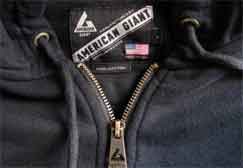The so-called "reshoring" trend we started hearing about five years or so ago received a lot of press for several years, fueled by a relatively small number of companies deciding to move or keep production in the US.
But despite all interest, it was hardly a sea change. Many surveys found lots of companies were thinking about reshoring back then, but not that many pulled the trigger in any meaningful way.
Supply Chain Digest Says... |
 |
| While helping to bring apparel and textile jobs back to the US, it's different world than back before the exodus away from the US. |
 |
What do you say? |
| Click here to send us your comments |
 |
| Click here to see reader feedback |
|
|
You certainly couldn't see a change in the numbers. US manufacturing output as measured monthly by the Federal Reserve is up just over 5% currently from 2012 levels, meaning average annual growth of well less than 1%.
The trade deficit in goods with China, though down recently, set new records almost every year. The recent decline in imports from China appear to have simply moved to countries such as Vietnam and Bangladesh.
The poster child in the decline of US manufacturing in recent decades is the apparel sector. Federal Reserve data says US apparel output fell an almost unbelievable 85% between 1987 and 2017.
One company taking a much different view is American Giant, a San Francisco-based manufacturer of sportswear and casual clothing. It currently makes 100% of its goods in the US, almost unheard of in the apparel sector.
The company's CEO, Bayard Winthrop, says in an age of import tariffs and changing politics, it may be time for other retailers and brands to rethink where they produce goods.
Speaking with Yahoo Finance, Winthrop recently said that "Brands are beginning to feel both from a moral standpoint and from a better business standpoint, about bringing some of their manufacturing back into a US supply chain."
He added that "It's a concern that there's been so much underinvestment in US manufacturing over the last 30 years or so. That's something that's impacted manufacturing broadly and textiles specifically."
One major advantage of American Giant's approach – it has barely been impacted by the tariffs on Chinese imports.
"Most of the last 40 years were marked by a massive movement overseas by all the brands that I grew up around," Winthrop noted.. "There are two things that have happened there. One is that the work has left and that's had real implications for towns, communities and middle class paying jobs.
The other he said is quality.
"American Giant is rooted in a quality story and trying to get quality back in the supply chain," Winthrop said.
Six years ago, the apparel manufacturer Eagle Sportswear, in rural Middlesex, North Carolina, was ready to close, until Winthrop helped buy the knitwear plant.
(Article Continued Below)
|
CATEGORY SPONSOR: SOFTEON |
|
|
| |
|
|
In another interview with CBS News, Winthrop said that "You cannot gut a bunch of communities in the US and move to Bangladesh and then import all those goods back again and sell them at the local Dollar Store to all these people that now no longer have jobs."
One thing American Giant faces is a major lack on production infrastructure and manufacturing know- how. how.
To get Eagle Sportswear going, Winthrop said the company had to bring an expert yarn dyer out of retirement to come back and help get production started effectively.
But while helping to bring apparel and textile jobs back to the US, it's different world than back before the exodus away from the US.
At Parkdale Mills in Gaffney, South Carolina, raw cotton is cleaned and spun into yarn as part of American Giant's supply chain. In the 1960s a mill like Parkdale would have employed 2,000 workers; today, there are just 125 workers, and about as many robots, producing 2 million pounds of yarn a week.
But for now, American Giant clothes are higher priced than similar imports – but the quality just isn't nearly as high as the US made products, Winthrop says.
A couple of years ago, the digital magazine Slate called one Giant Eagle offering "the greatest hoodie ever made."
Sales have been up ever since.
What do you think of American Giant's strategy? Is there pressure to bring production back to the US? Let us know your thoughts at the Feedback section below.
Your Comments/Feedback
|